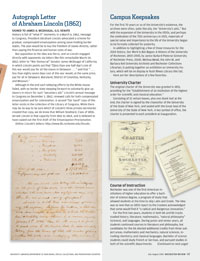Features
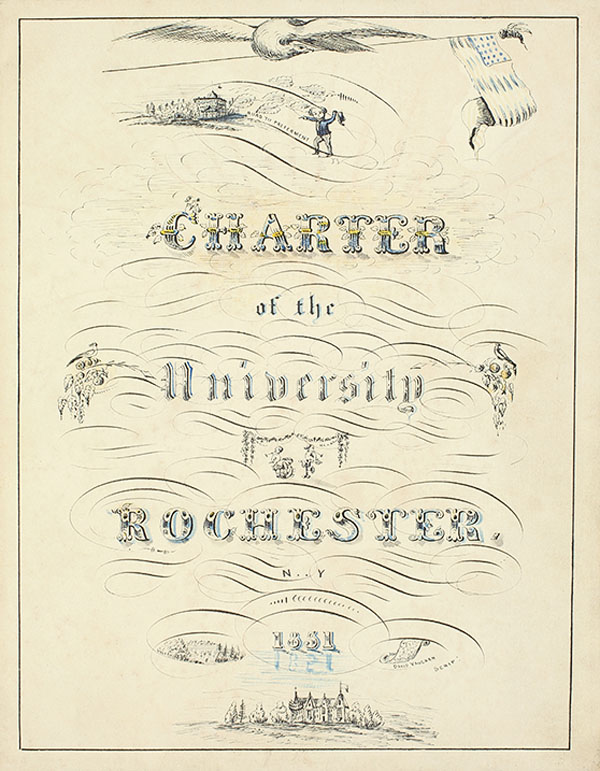
University Charter
The original charter of the University was granted in 1851, providing for the “Establishment of an institution of the highest order for scientific and classical education.”
Consisting of 12 vellum leaves, plus one blank leaf at the end, the charter is signed by the chancellor of the University of the State of New York, and sealed with the Great Seal of the University of the State of New York. A key symbol of office, the charter is presented to each president at inauguration.
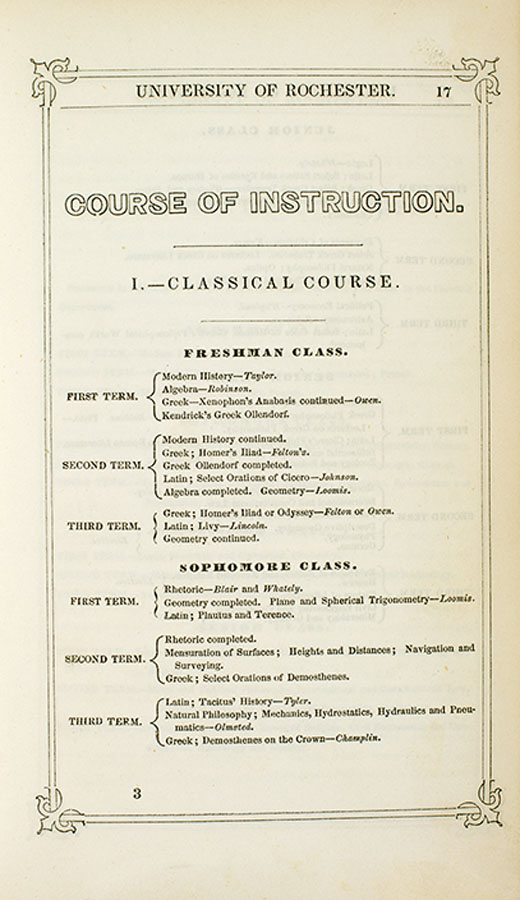
Course of Instruction
Rochester was one of the first American institutions of higher education to offer a bachelor of science degree, a program of study that allowed students at the time to skip Latin and Greek. The idea was so new that an 1850 report to the trustees acknowledged that some would find it “a radical and dangerous innovation.”
For the first two years, students in both BA and BS tracks studied history, literature, mathematics, “natural philosophy” (science), and languages. During junior and senior years, all students continued courses in literature and philosophy, but candidates for the BA elected additional credits from three subject areas: mathematics and mechanics; natural sciences, including chemistry; and classical languages. Bachelor of science students could study French or German, and pursued studies in both of the scientific departments.
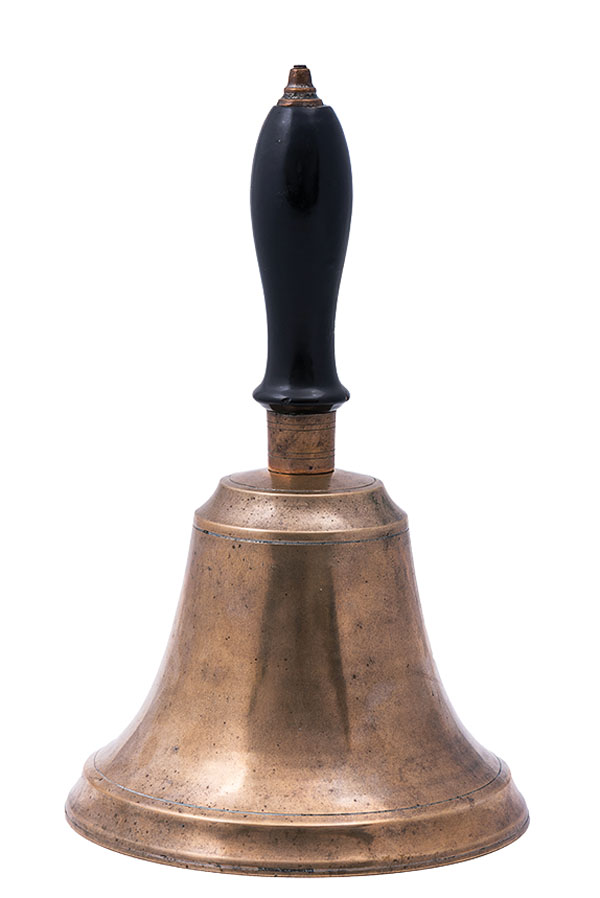
The ‘Anderson Bell’
The bronze bell summoned students to class at the United States Hotel until 1861, and in Anderson Hall until 1876. The bell ringer was usually the janitor—James Noble and his successor, Elijah Withall—who would take it out of a locked cupboard and ring it on the hour.
With the addition of Sibley Hall, the handbell was replaced by one that was rung using a rope and could be heard in both buildings.
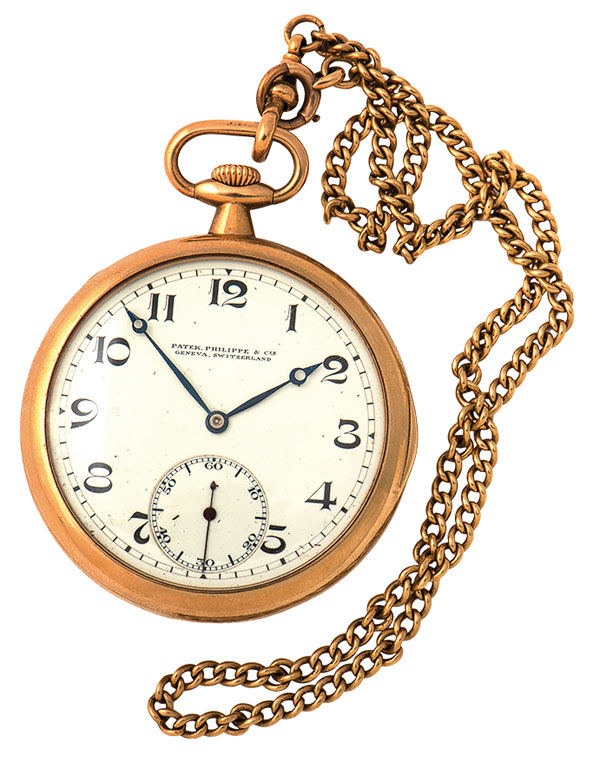
Rush Rhees’s Pocket Watch
A colleague from Rush Rhees’s years at Newton Theological Institution (1892–1900) reminisced: “He seemed to me like a well-adjusted, well-oiled machine, working to the exact second without hurry or fuss. I was puffing up the hill one day. Rhees said, ‘Plenty of time.’ He then told me that after much experience he had calculated that if he was at the tree at the corner of Chase Street by the time the bell rang in Colby Hall tower, his usual pace would land him at his classroom desk in ample time to be composed when the buzzer rang. If the bell rang before he reached the tree, he must put on steam, and that he disliked to do. I took it that this was an application of his mathematical training to affairs of daily life. He was quick in thought, speech, and action, but I have no recollection of any sign of nervous haste or ‘rush’ in my five years’ association with him.”
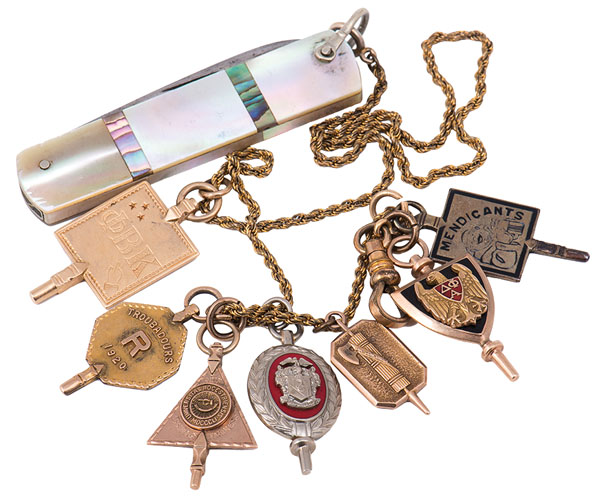
Metzdorf Pocket Knife and Keys
The fraternity and honorary society keys belonged to Robert Metzdorf ’33, ’39 (PhD), a prominent bibliographer and appraiser of rare books and manuscripts. Attached by a chain to his mother-of-pearl pocketknife, they include his Phi Beta Kappa key, and fobs of Delta Rho, the Troubadours, Pro Concordia, the Mendicants, and Delta Phi Alpha, and an alumni award from Theta Chi, presented to him in 1949.
Metzdorf earned the first PhD in English from the University; his thesis was an examination—still consulted to this day—of the autograph collection given to the University by Charles Brown, Class of 1879, trustee, and eponymous donor, with Francis Welles, Class of 1875, of the Welles-Brown Room.
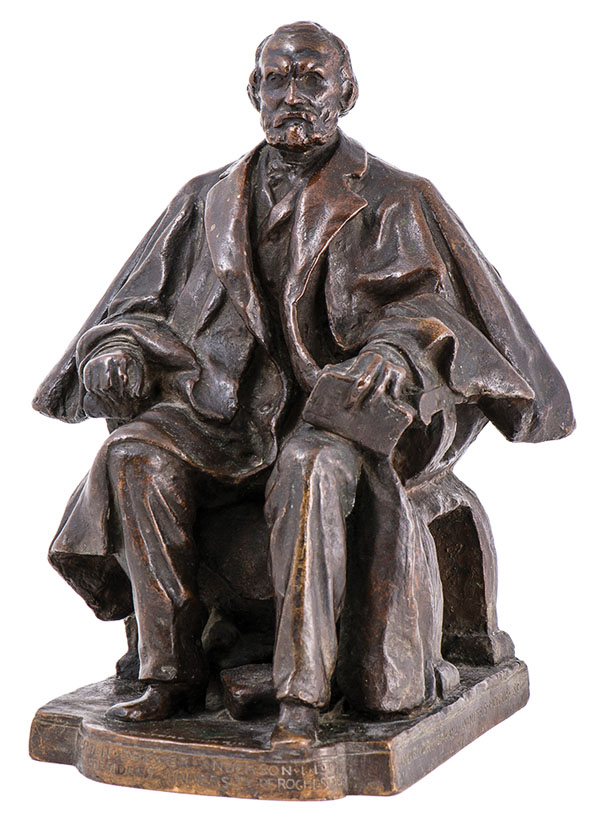
‘Unused’ Version of the Anderson Statue
The statue of a boldly striding Martin Brewer Anderson is a familiar and beloved sight, dating to 1905 when it was first placed in front of Anderson Hall on the Prince Street Campus; with the merging of the colleges for men and women, the statue was transferred to the River Campus where it stands in the Wilson Quadrangle.
But there’s another Anderson statue, one which was created by one alumnus and given by another. Paul Winters Morris attended Rochester for two years from 1882 to 1884 and then again from 1884 to 1886 but did not finish his degree. Instead he went on to study sculpture with Augustus St. Gaudens and Daniel Chester French in New York City, and then moved to Paris to continue his training. Morris died of pneumonia in 1916 in New York City.
According to a 1918 letter from Waldo Morse, Class of 1882, to President Rush Rhees, Morse’s widow discovered the model for the statue in her husband’s studio and showed it to French, “who pronounced the work to be a gem.”
The decision to portray Anderson seated may be a result of timing: Morris knew Anderson in the last decade of the president’s life, when rheumatism had taken its toll and he walked with two canes.
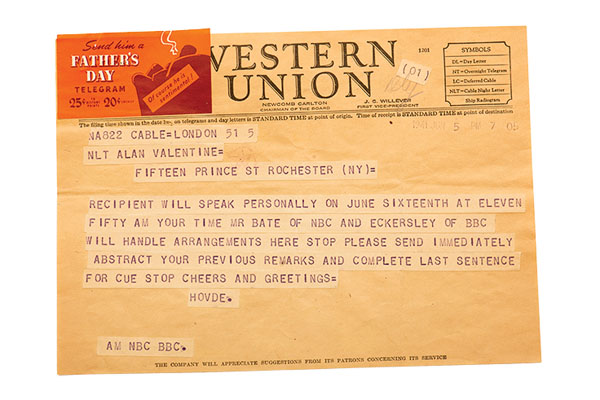
Churchill Telegram
“Members of the Class of 1941 will probably remember their Commencement day for many years to come,” reported that year’s June-July Rochester Review. Graduates sitting in Eastman Theatre, along with millions of others, heard Winston Churchill give his first address to an American audience since taking the post of England’s prime minister.
The announcement of the degree, Churchill’s first from an American university, was held as top secret up to the day of graduation, as the telegram from Frederick Hovde to Alan Valentine confirms.
Valentine’s initial proposal to Churchill dates to January of 1941, and begins: “Acting for the Board of Trustees of this University, I convey to you a very cordial invitation to receive from this University the degree of Doctor of Laws, honoris causa, in absentia, on the Annual Commencement Day, June 16, 1941, provided that you are willing at that time to accept that degree by a verbal response via short wave radio, arrangements for which will be made by this University.”
For the first 70 years or so of the University’s existence, the archives were often, quite literally, the “University’s attic.” But with the expansion of the University in the 1920s, and perhaps the celebration of the 75th anniversary in 1925, materials of special value and importance to the life of the University began to be formally collected for posterity.
In addition to highlighting a few of those treasures for the 2014 history, Our Work Is But Begun: A History of the University of Rochester, 1850–2005, by Janice Bullard Pieterse (University of Rochester Press, 2014), Melissa Mead, the John M. and Barbara Keil University Archivist and Rochester Collections Librarian, is putting together an exhibition on University history, which will be on display in Rush Rhees Library this fall. Here are her descriptions of a few favorites:
Rochester Review
July-August 2014
Vol. 76, No. 6

